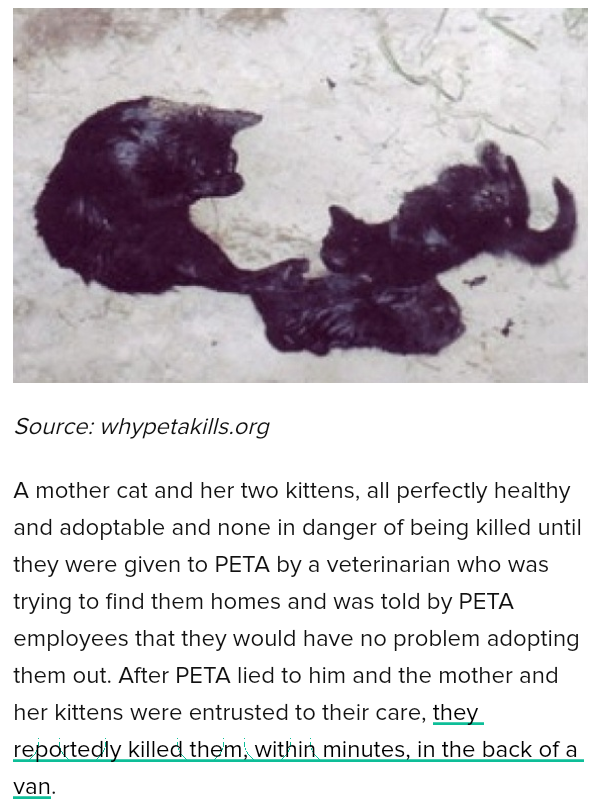The debate surrounding the actions of the People for the Ethical Treatment of Animals (PETA) often ignites passionate discourse. At the center lies a perplexing dichotomy: the organization’s self-proclaimed purpose of advocating for animal rights versus its contentious practice of euthanizing healthy animals. It raises a myriad of questions regarding the ethics of animal advocacy, the responsibilities of humane organizations, and the societal perceptions of animal welfare. The act of euthanizing animals that are otherwise fit for adoption, indeed, proves to be a polarizing issue among animal lovers and activists alike.
To dissect this phenomenon, it is imperative first to understand the operational framework of PETA. Founded in 1980, PETA aimed to promote awareness and instigate societal change against the exploitation of animals. The organization vehemently opposes factory farming, animal testing, and other forms of animal exploitation. However, the revelation that PETA’s shelters have euthanized thousands of animals over the years has provoked considerable backlash. This paradox raises questions about the objectives guiding their euthanasia policy, thus inviting an analytical exploration.
One pertinent point within this controversy is the overpopulation of animals in shelters. In many municipalities across the United States, the number of stray and abandoned animals exceeds the capacity of available homes. Shelters often struggle to find adequate placements for these animals, leading to heart-wrenching decisions regarding euthanasia. PETA, positioning itself as a champion for animal welfare, faces the grim reality that without sufficient adoptive homes, some animals may suffer prolonged periods of neglect, illness, or distress. The organization posits that in certain circumstances, euthanasia is seen as a humane alternative to prolonging suffering.
Moreover, a critical aspect to consider is the definition of “healthy” within the context of animal shelters. While many may regard an animal as healthy due to the absence of apparent physical ailments, a host of behavioral issues may render these animals unsuitable for adoption. Factors such as aggression, anxiety, or even a history of trauma can complicate the potential for a successful placement. PETA has argued that in instances where an animal has significant behavioral challenges—despite being physically healthy—the most humane and ethical choice may ultimately be euthanasia. This perspective, however, opens a Pandora’s box of ethical considerations regarding animal autonomy and the responsibility of humane organizations to rehabilitate rather than terminate.
In addition to the practicalities surrounding adoption and shelter capacity, there lies the question of public perception and its influence on PETA’s decision-making. The organization’s image and mission are invariably tied to the contention surrounding euthanasia practices. Critics argue that PETA’s choices contradict the fundamental philosophy of advocating for animal rights. This dissonance is exacerbated by the emotional responses associated with animal death. The juxtaposition of PETA’s activism against a backdrop of euthanasia creates a sense of disillusionment among those who value their work. The perception often leads to a belief that PETA prioritizes its ideology over humane treatment.
Beyond mere statistics and operational necessities, the underlying motivations driving such euthanasia practices warrant scrutiny. Some theorists suggest that PETA adopts this stringent stance in a bid to promote a broader message regarding animal care and responsibility. By promoting the idea that not every animal can be saved or placed, PETA may aim to galvanize public consciousness toward the crucial importance of spaying and neutering, thereby reducing future animal overpopulation. In essence, PETA could be leveraging the contentious nature of euthanasia to foster a larger dialogue about responsible pet ownership and humane treatment of animals, albeit at the risk of appearing contradictory in their methods.
Furthermore, this entire ordeal beckons a more profound inquiry into societal attitudes toward euthanasia itself. In administering a life-ending decision, ethical and philosophical dimensions emerge. Many cultures grapple with the moral implications of life and death, especially concerning sentient beings incapable of voicing their desires. The juxtaposition of compassion versus duty renders this issue particularly nebulous. PETA’s actions may induce some to rethink their preconceived values regarding animal life and the ethical ramifications of individual agency versus collective responsibility.
As one navigates through the complexities inherent to this controversy, it is essential to engage in holistic critiques rather than merely settling on emotionally charged responses. Understanding the multifaceted dimensions of PETA’s actions necessitates a measured examination of the socio-political landscape influencing animal welfare initiatives. The conversation surrounding euthanasia within animal advocacy remains fraught with tension, ultimately culminating in a call for a more profound engagement with the pressing issues of homeless animals, societal responsibility, and compassionate advocacy.
In conclusion, the polarizing practices attributed to PETA concerning the euthanasia of healthy animals illuminate critical intersections in animal rights movements. As advocates, activists, and everyday citizens ponder these practices, it is paramount to grapple with the ethical implications, societal attitudes, and pragmatic realities of animal care. Euthanasia, as contentious as it is, may serve as a catalyst for necessary dialogues surrounding our responsibilities to all sentient beings, propelling us toward a future poised to reduce suffering through understanding, awareness, and responsible actions.






